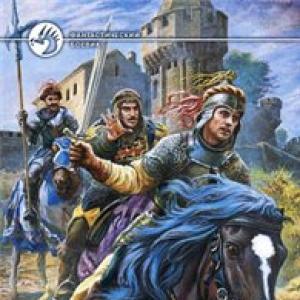Ending s es. When in English the ending s is put and when es
There are several distinguishing features in English. One of them is the apostrophe. This small sign, at times, becomes a big problem for students, since many people confuse when to put an apostrophe and when not.
Today we will deal with its use once and for all. In the article you will learn:
- use of the apostrophe to indicate ownership
What is an apostrophe in English?
Apostropheis a superscript comma (").
Although we do not use this sign in Russian, I think you probably saw it. Many foreign names are abbreviated with the apostrophe. For example: d "Artonyan instead of de Artonyan.
An apostrophe in English is used in 2 cases that can be easily remembered:
1. To show affiliation
2. To indicate a gap when abbreviations
Let's look at each of these use cases in detail.
Use of the apostrophe to indicate ownership

We use the apostrophe to show the affiliation of the subject / person. To do this, we just need to add "s to the word that calls the owner.
To test ourselves, we can ask questions like this: whose ?, whose ?, whose ?, whose ?. For example: Tom's computer (whose?), Sisters 'dress (whose?), Dogs' ball (whose?).
Examples of using the apostrophe:
Give me Ann ’S copybook.
Give me Anne’s notebook.
This is my parent "s car.
This is my parents car.
I took my friend ’S phone.
I took a friend's phone.
Books lie on teacher ’
s desk.
Books are on the teacher’s desk.
He ate his sister ’S cookies
He ate sister's cookies.
When is the apostrophe in English still put?
Also in this rule there are several nuances to keep in mind:
1. Owners are a few people / animals.
In this case, to the word that indicates them (it will be in the plural), we simply add an apostrophe (") without the letter s . Indeed, we already added the ending -s to such words to form a plural form (cat - cats - cats ", girl - girls - girls", sister - sisters - sisters ", friend - friends - friends").
However, if the word is not formed according to the rules (you can read about such exceptions), then we add "s:
2. Two owners
For example: mother and father, Tom and Peter, Mary and Jane.
There are two options for adding an apostrophe.
- One item belongs to two people.
We add "s to the last word: mother and father" s, Tom and Peter "s, Mary and Jane" s
Mother and father "s car stays in garage.
Mom and Dad's car is in the garage. (It's about one car that belongs to two people)
Tom and mary "s house is big.
Tom and Mary's house is big. (This is one house belonging to both Tom and Mary)
- Each owner has his own item that belongs to him.
We add "s to every word: mother" s and father "s, Tom" s and Peter "s, Mary" s and Jane "s
Mother "s and father "s cars stay in garage.
Mom and Dad's cars are in the garage. (We are talking about two cars: one belongs to mom, the other to dad)
Tom ’S and mary "s houses are big.
Tom and Mary's houses are big. (This is about two different houses that have different owners)
Apostrophe with possessive pronouns in English
We do not add "s to possessive pronouns (her / hers, your / yours, their / theirs), despite the fact that they answer the questions: whose ?, whose ?, whose ?.
Wrong: She lost her "s pen.
Right: She lost her pen.
Using the Apostrophe to Shorten English Words

In English, we can shorten some words. In such cases, we put the apostrophe (") in the place of missing letters.
Here are the main abbreviations accepted:
I am \u003d I "m
You are \u003d you’re
He is \u003d he’s
I have \u003d I’ve
I would \u003d I’d
I will \u003d I’ll
not \u003d n’t
Examples:
He "s studying now.
He is studying now.
We’re ready.
We are ready.
I "m calling him.
I call him.
They can’t leave.
They cannot leave.
I’ll translate.
I will translate.
So, an apostrophe is a superscript (") comma. It is used to show affiliation or to shorten. Now let's practice using it in practice.
Assignment task
Translate the following sentences into English:
1. This is the wedding of my friends.
2. Take Tom's car.
3. This is my dog’s ball.
4. We will live in her parents' house.
5. Bring Kate and Peter laptops.
6. He ate Dasha’s apple.
7. Peter’s friends will arrive tomorrow.
8. Phones of John and Mary are on the table.
Leave your answers in the comments under the article.
English is a storehouse of exceptions, special cases and sustainable designs. People who are just beginning to study it, of course, are scared off by peculiar rules, and especially exclusions from them, but these difficulties arise only at first. As you master English grammar, students come to understand the simplicity and logic of this foreign language. And what was difficult at first glance, from the second it becomes immediately clear and obvious. We will verify this in practice by examining today's topic: the ending of s in verbs in English, as well as the use of endings in nouns and adjectives.
Russian speech refers to synthetic languages, that is, to compose the correct context, we bow words, add prefixes and suffixes to them, and also swap any members of the sentence. English, by contrast, is a representative representative of the analytic language group. In his system, the main emphasis is placed on a strictly fixed order of sentence members, and the additional expression of relations is carried out using official and auxiliary words. Simply put, in such a speech, the relationship between the words does not convey the end of these words, but their place in the sentence and the proximity to the prepositions.
- Beautiful cat a sitting at the door -Abeautifulcat issittingatthedoor (word order - subject).
- I see a beautiful cat at – Iseeabeautifulcat (word order is an addition).
- I go to a beautiful cat e . – Igoto abeautifulcat (preposition of direction + addition).
As can be seen from the examples, the British are perfectly dispensed with a system of declension of words. But the grammatical category of endings in their language still exists, and has as many as three representatives. We will find out how they look and what their purpose is in the following sections.
The ending s of verbs in English
The most common case of using an extra letter at the end of words is to put the verb in 3 person singular simple present tense. It includes the pronouns he, she, it (he, she, it) and nouns that can be replaced by these pronouns. Recall that it denotes only inanimate objects, which in English may include animals (if they are not pets).
Simple describes regular, ordinary, habitual actions, so it can often be found in the speech of the British. Accordingly, the incorrect statement of the predicate in the third person is a very gross mistake, which will cut the ear to the foreign interlocutor. In order not to blush for your English, you need to remember a simple rule.
Consider the use of this law in practice.
- Shewatch es manyTvshowseveryday - She watches a lot of television shows every day.
- It sound s very strange - This sounds highly weird.
- He eats chip s and drink s lemonade - He eating crisps and drinks lemonade.
For a third party, the verb ending is also saved in a negative and interrogative form, undergoing a slight change to - es, and adding not to the main, but to the auxiliary verb. Moreover, the main predicate is in the form of a simple infinitive.
- Do esJessica write letter to him? - She do esn’t write letter to him.
- Does Jessica write him a letter? “She doesn't write him a letter.”
- Do es a koala become a big and strong animal? - It do esn’t become a big and strong animal.
- Is a koala becoming a big and strong animal? - She does not become a big and strong animal.
- Do es your father work as a lawyer? - He do esn’t work as a lawyer.
- Does your father work as a lawyer? - He does not work as a lawyer.
The ending s of Present simple verbs in English has its own nuances of usage and pronunciation, which the table below will help us to analyze.
| Category | The rule | Example |
| Spelling | Verbs ending in the letters o, x or the combinations –ch, sh, ss, zz, tch require putting the ending in the form - es. | Father wash es (wash) his car once a week - father washes his a car time in a week. |
| Predictions that end in –y have two spellings. If the word has a vowel in front of –y, then no changes occur, just s is added to the ending. In verbs with a consonant preceding y, the transformation y → I occurs, and then -es is added. | Jackplay s
(pl ay
) basketballverywell - Jack plays basketball very well.
The rule appl ies (app ly ) to verbs and nouns - The rule applies to verbs and nouns. |
|
| Pronunciation | The ending s reads as [s] ( russian with) in cases where it is preceded by a dull consonant sound. works, sleeps, calls, stops and t.P. |
My little son always sleep s
with toys.
My little son always sleeps with toys |
| The ending s reads as [z] ( russian h) if there is a pronounced vowel or voiced consonant in front of him. opens, reads, plays, sings and t.P. |
She play s
tennis twice a week.
She plays tennis twice a week. |
|
| The ending es is pronounced as (of). Additional es should not be confused with the simple addition of s to a verb with unpronounceable e. |
He usually watch es
(of) horror movies.
He usually watches horror films. She like s (c) to dance. She likes to dance. |
At the end of the section, we note that in the third person, the verbs have (3 l. - has) and to be (3 l. - is, in a special form PastSimple - was). In sentences, such a construction is often shortened to form окончания s endings. It ’ s (is / was) a pen. He ’ s (has) learnt 10 words.
S ending in nouns
The second most popular way to meet the English ending is to make the plural of the noun or put it in the possessive case. In both cases, nouns in English add the letter s to the stem.
Usually, the plural is formed by adding the prime s. But, if we take a noun ending in sh, tch, ss, ch, x, o, then the ending, as in the case of verbs, turns into es. An important role is played by borrowed nouns ending in –o. They, unlike native English words, will only accept the letter s.
- Mygrandparentsgrowpotato es andtomato es atthedacha - My grandfather and grandmother grow potatoes and tomatoes in the country.
- Wherearemyphoto s fromthebirthdayparty? - Where are my birthday party photos?
Another important feature is related to nouns ending in f / fe. In most cases, they change these letters to v and get the ending es. But there are some exceptions that use the letter s.
- Therearemanyshel ves intheroom - The room has many shelves.
- The cats like to walk on the roof s - cats love walk by to the roofs.
In other cases, the rules for reading, spelling and pronunciation of s in English for nouns completely coincide with the table given in the section of verbs.
As for possessive forms, their ending is formed using a special symbol - the apostrophe (‘). Nouns hours receive the ending –‘s, and noun. many h, if they already end in s receive only an apostrophe.
- I remember my parents ’advice - I I remember advice my of parents.
- Jack’s life is very interesting - Life Jack highly interesting.
Endings ed and ing
And the last part of the speech that English grammar endowed with endings is adjectives with endings ed and ing. The roots of their education lie in verbs, so they can rightfully be called participles. In English, these adjectives are characterized by the expression of active or performed actions, which corresponds to Russian real and passive participles. Basically, both types of these words coincide, and differ only in additional endings. Therefore, it is important to understand what these endings hide in themselves.
Adjectives with the ending ing convey the characteristics of the person / object, its ability to take active actions, influence on someone. The expression answers the question “What?” And refers to the object of speech, and not to the speaker. It is noteworthy that the form of the word completely coincides with the English participle of the present (participle I).
- I watched an interesting film yesterday - I looked yesterday interesting film.
- This lesson is very boring - This lesson highly boring.
- It was an amazing evening - This was amazing evening.
Adjectives with ed in English express the other side: the impact exerted by the subject. With their help, the speaker describes his condition; the impression made upon him by the subject of conversation. Such constructions correspond to the past participle form (participle II).
- She was disappointed that her boyfriend hadn’t called her - She was disappointed by, what her guy not called her.
- I was surprised that all my books were sold for 2 weeks– I was surprised to that, what all my the books were sold out behind 2 weeks.
- My little brother is tired of his homework - My younger brother tired from his home work.
The examples show that the meaning of the whole utterance depends on the use of the ending. Therefore, you must be able to navigate in cases where the endings ed and ing are used.
As we learned from the material, endings in English have an important function and can correspond to three parts of speech. Let's check the assimilation of the theory by doing some small exercises.
This is actually all the endings that are found in it. Unlike the Russian language, which is rich in various endings. Due to the fact that there are only three endings in English, their use is found everywhere: in verbs, and in nouns, and in adjectives, and in gerund, and in participles. Let's dwell on each of the endings and identify the most common cases of their use.
S ending in English
So ending - s in English (also - es) is used in the following cases:
- The plural of nouns is formed by adding the ending -s to the noun:
- If the noun ends in -ss, -x, -z, -ch, -sh or -o, the ending -es is added:
- However, nouns borrowed from other languages \u200b\u200band ending in –o add the ending -s:
- The ending - s in English (also - es) is used when using verbs in the third person singular in Present Simple (for he, she, it):
- This ending is still used to form the possessive case of the nouns, which is written through the apostrophe:
- If the noun is in the plural or ends with -s, then we put only the apostrophe:
cat - cats;
table - tables;
disk - disks;
window - windows.
fox foxes
bush - bushes;
potato - potatoes
dress - dresses.
photo - photos;
piano - pianos.
I play - he plays;
We go - she goes;
They see - it sees;
my mother’s coat - my mother’s coat;
brother’s cup - a cup of a brother;
Susan’s sister is Susanna’s sister.
his parents ’anniversary - the anniversary of his parents;
students ’books - student books;
Lucas ’wife - Lucas’s wife.
English ending ed
When do they use the ending ed in English?
- If the verb is used in Past Simple and it is correct, you need to add the ending - ed:
- Also, this ending is used if it is a third form of the correct verb (past participle) in Perfect tenses:
- A verb with a ending - ed is sometimes translated as an adjective (which? Which? Which? Which?)
She wached the concert yesterday. - She watched a concert yesterday.
He looked for it two days ago. “He looked for him two days ago.”
I borrowed this dress from a friend. - I borrowed this dress from a friend.
She has learned English since she was 5.
The snow had stopped when we arrived.
I will have dressed the baby by 10 a.m.
folded T-shirt - folded t-shirt;
blessed marriage - blessed marriage;
opened door - an open door.
Always look whether a noun follows such a word to know which part of the speech is more correct to translate a verb with an ending; ed.
English ending ing
When do you use the ending ing in English?
- If we are talking about the fourth form of the verb (or the participle of the present tense) - the tenses of the Continuous group:
- We can also translate a word with the ending - ing an adjective if it is followed by a noun connected with it in meaning:
- You can also translate a word with the ending - ing a noun (see the topic of Gerund) - it all depends on the context and order of words:
She is typing now.
He was walking along the street when he saw an accident.
I will be reading tomorrow at 5 p.m.
sleeping baby - sleeping baby;
crying lady - a crying woman;
boring book is a boring book.
Stealing is a crime. - Theft is a crime.
Walking is good for your health. - Walking is good for health.
I like dancing. - I love dance.
Endings -es and -s in English are quite common. Every English learner needs to understand the rules for using the above endings.
This article will help you quickly and easily understand the essence of this grammar material. So ending -s can serve:
1) indicator of 3 liters. units h. verb c;
2) a sign;
3) an indicator of the possessive case of nouns;
4) reduction.
Rules for using the ending -s / -es have their own specifics. In the affirmative form of the third person singular, the ending is most often added to the verb -s BUT after the root bases on -sh, -ss, -oetc. (see rule below) we use the ending - es . For instance,
Pass - passes;
Kiss - kisses;
Finish - finishes;
Wash - washes;
Do - does;
Go - goes.
-S ending in Present Simple
We use present simple to express regular action or constant situations. Ending -s in the third person h (he, she, it) in time of the English verb Present Simple should be added if the subject matches the pronouns “He”, “she” or “it”.
Rules for writing verbs in the third person singular in Present Simple
If the verb ends with –Ss, sh, ch, x, o - then the ending is added -es .
I always wash up at home.
He always wash es up at home.
If the word has an ending to the consonant and subsequent -y , then -u changes to - i plus is added -es .
I sometimes cry.
Baby sometimes cr ies.
If the last letter of the verb is a vowel -ythen only -s .
I often play with this toy ship in the afternoon.
Alla often play s with this toy ship in the afternoon.

Reading the endings of the verbs in the third person singular

Remember: In negative and interrogative forms, where the auxiliary verb is used does (not), the main verb has no endings -s, -es .
Does she sing every day?
Ann doesn’t go to that college.
Remember to spell verbs to have and. If these verbs are in the third person singular, then they change dramatically. This can be seen in the following examples:
Daddy has much money.
Jane is tired of doing numerous exercises.
-S ending in nouns
Ending -s found not only in verbs, but also in nouns. In the case of nouns, similar endings are usually found in the plural or in the possessive case. If we are talking about people and animals in the possessive case, then we use ’ s in the case of one actor.
This is the girl ’ s doll. - This is a girl’s doll.
The cat ’ s tail is long. - The tail of the cat is long.
But should be used s ’ in case two or more actors, people or animals are involved.
These are the boy s ’ boots. - These are boys' boots.
In English, there are exception nouns that create the possessive case in the following way:
Those are the men ’S hats. - That's men's hats.
See full list of such exceptions.
Acronyms with ’s
And finally ’S may be not only an indicator of the possessive case, but also a reduction. For instance:
it is \u003d it’s
that is \u003d that’s
let us \u003d let’s
How long has it been? \u003d How long’s it been?
Other abbreviations can be studied in more detail and.
when in English is the ending s and when is es?
- A lot of options. If everything is reduced to one rule, then it will sound something like this:
in the general case, S is put, and ES is an auxiliary tool.http: // www. alleng. com / mybook / rn3-3. htm
remove all spaces from the link - he, she, this is the 3rd person singular in the simple present tense :)) I wanted to write, in more detail, but I can’t, "The answer cannot be added.
Try not to use characters from the English layout in the answer.! " -
Examples:
book books book books;Examples:
bru sh brush es brush;
cargo cargo es cargo;
tax taxes
Examples:
Examples:
s.Examples:
key key s key keys;
Examples:
wife wi ves wife of the wife;
life lives life;
wolf wol ves wolf wolves;
Examples:
hoo f hoofs hoof hoof;
reef reef s reef reefs;
roo f - roofs roof roof;
sa fe safe s safe deposit boxes; - The ending -s / -es is added to the nouns to form the plural. The ending -s / -es is added to the verbs for the formation of 3 singular persons in the form of Present Simple (Present Indefinite). The rules for adding -s / -es to nouns and verbs are almost the same.
1. The standard case of adding the ending s to a noun or verb.Examples:
book books book books;
to look (he / she / it) look s look (he / she / it) looks; 2. If the noun or infinitive of the verb ends with -o or sh, -ch, -x, -ss, -tch,
then the ending es is added to the wordExamples:
addre ss addresses address address;
bru sh brush es brush;
cargo cargo es cargo;
tax taxes
church churches
to pass pass es pass (he / she / it) passes;
to sma sh smash es crash (he / she / it) crash;
to d o does do (he / she / it) does;
to rela x relaxes relaxing (he / she / it) relaxes;
to ca tch catch es catch (he / she / it) catches;
to teach teaches to teach (he / she / it) teaches;
Note that nouns borrowed from other languages \u200b\u200band ending with
on o, add the ending -s.Examples:
photo photo s photography photograph;
pian o 2 piano s piano 2 piano;3. If the noun or infinitive of the verb ends in -y with the previous consonant, then the ending es is added, and y is replaced by -i.
Examples:
bab y bab ies infant babies;
to fl y flies fly (he / she / it) flies;
Note that if -y is preceded by a -y, then -y is saved and the ending is added
s.Examples:
key key s key keys;
to stay stay s stop (he / she / it) stops;
4. If the noun ends in -f, -fe, then the plural form
replaces -f, -fe with v and adds the ending -es.
Examples:
wife wi ves wife of the wife;
life lives life;
wolf wol ves wolf wolves;
However, for some nouns ending in -f, -fe, when forming
the plural does not replace f with v. Plural forms only
by adding the ending s.
Examples:
chief chief s chief;
hoo f hoofs hoof hoof;
reef reef s reef reefs;
roo f - roofs roof roof;
sa fe safe s safe deposit boxes;
handkerchie f handkerchief s scarf shawls; - The ending -s / -es is added to the nouns to form the plural. The ending -s / -es is added to the verbs for the formation of 3 singular persons in the form of Present Simple (Present Indefinite). The rules for adding -s / -es to nouns and verbs are almost the same.
1. The standard case of adding the ending s to a noun or verb.Examples:
book books book books;
to look (he / she / it) look s look (he / she / it) looks; 2. If the noun or infinitive of the verb ends with -o or sh, -ch, -x, -ss, -tch,
then the ending es is added to the wordExamples:
addre ss addresses address address;
bru sh brush es brush;
cargo cargo es cargo;
tax taxes
church churches
to pass pass es pass (he / she / it) passes;
to sma sh smash es crash (he / she / it) crash;
to d o does do (he / she / it) does;
to rela x relaxes relaxing (he / she / it) relaxes;
to ca tch catch es catch (he / she / it) catches;
to teach teaches to teach (he / she / it) teaches;
Note that nouns borrowed from other languages \u200b\u200band ending with
on o, add the ending -s.Examples:
photo photo s photography photograph;
pian o 2 piano s piano 2 piano;3. If the noun or infinitive of the verb ends in -y with the previous consonant, then the ending es is added, and y is replaced by -i.
Examples:
bab y bab ies infant babies;
to fl y flies fly (he / she / it) flies;
Note that if -y is preceded by a -y, then -y is saved and the ending is added
s.Examples:
key key s key keys;
to stay stay s stop (he / she / it) stops;
4. If the noun ends in -f, -fe, then the plural form
replaces -f, -fe with v and adds the ending -es.
Examples:
wife wi ves wife of the wife;
life lives life;
wolf wol ves wolf wolves;
However, for some nouns ending in -f, -fe, when forming
the plural does not replace f with v. Plural forms only
by adding the ending s.
Examples:
chief chief s chief;
hoo f hoofs hoof hoof;
reef reef s reef reefs;
roo f - roofs roof roof;
sa fe safe s safe deposit boxes;
handkerchie f handkerchief s scarf shawls;







